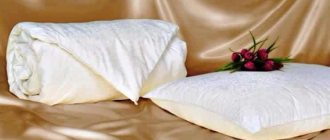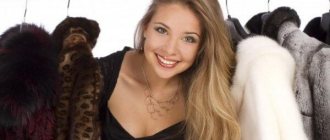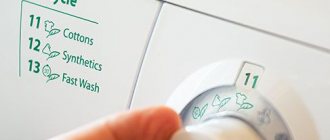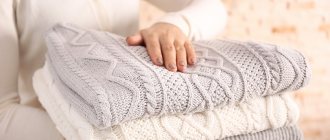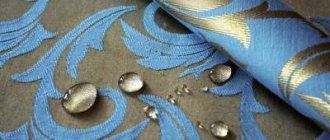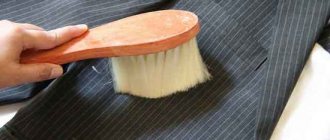The main substance found in silk is the protein fibroin. Therefore, the properties of silk differ from the properties of plant tissues.
One of these differences is sensitivity to mechanical stress and high temperature. Because of this, silk needs proper care, part of which is washing.
If you neglect it, silk fabric will not last long. Let's talk in more detail about whether silk can be washed and how to do it correctly.
Natural silk - machine washable
After studying the manufacturer's recommendations, if there are no prohibitory signs, you can proceed. The items are placed in a washing net and placed in the washing machine. On the control panel, select the “delicate” or “manual” mode. Set spin to minimum or turn off completely. Silk is damaged by temperature changes. The temperature mode should be 30 °C or turn off the heating completely.
After the cycle is completed, the items are removed and, if necessary, carefully wrung out by hand. You can use a towel or thick cotton cloth. Complete drying at room temperature.
Colorful and plain silk bed linen will retain its original appearance if rinsed with water acidified with vinegar. After the procedure, the color is restored and the pattern looks brighter. An antistatic agent and silk rinse aid are also recommended at the rinsing stage.
Areas of use
Silk fabrics are used for sewing summer and winter clothes, as the fabric maintains a comfortable temperature in any weather. Silk clothing looks attractive and is suitable for business meetings, everyday wear, and festive events.
Not only silk clothing is popular, but also home textiles made from silk. The material is used to make roller blinds, drapes, bed linen, pajamas, dressing gowns, slips, and underwear. Silk threads are used not only for the production of fabrics. Various crafts are made from them, used in knitting, embroidery, and as a basis for paintings.
Features of hand washing
The optimal solution for caring for silk items is hand washing. Especially when it comes to natural products that require careful handling. It is necessary to fill a plastic container with warm water (t = 30-40°) and stir shampoo for delicate fabrics, soap shavings, clear liquid soap or regular shampoo into it. Wardrobe items are placed in foam and left for 15 minutes. Natural silk must be washed in large volumes of water.
Then you need to wash it carefully. Do not rub, twist or pull the fabric. Water softens the structure of the fibers, and they are easily damaged by mechanical stress. Then carefully rinse the items in several waters. Use a lower temperature for each water change. Remove water with gentle movements. Spread the items to dry on a terry towel. Avoid exposure to hot air from a heater or radiator.
How to dry it?
Since silk fibers are very sensitive to physical stress, they can break even if hung on a clothesline under the weight of wet fabric. Therefore, drying silk items requires a special approach.
To dry the product, lay it out on a flat surface and wait until the moisture has completely evaporated . In this case, it is undesirable for the fabric to be exposed to direct sunlight.
You will find maximum useful information about washing clothes and various fabric products here.
Homemade laundry products
Despite the emergence of specialized detergents, folk remedies are no less popular and give good results.
- Potato broth will help you care for brightly colored fabrics. To prepare it, you need to boil 1 kg of potatoes in 3 liters of water. When ready, drain and cool. Leave silk products in the broth for 2 hours. After this, add 2 tbsp. l alcohol and hold for 20 minutes. Rinse the silk in several waters and dry.
- Potatoes are also used raw. It is cleaned and grated. Squeeze the juice through cheesecloth and mix with water. Wash without adding detergents.
- Hydrogen peroxide will help restore the whiteness of white fabric and eliminate yellow stains. The solution is prepared from 15 measures of water and one part of 3% peroxide with the addition of 3 drops of ammonia. Bleaching duration is 15 minutes at a temperature of 30°. During exposure, the item will need to be stirred several times. Finally, rinse with warm water.
- Silk scarves and handkerchiefs are washed in a decoction of white beans or beans.
- To remove stains, use a paste of starch mixed with a small amount of water. The composition is applied to the contaminated area and left until dry. Dry residues are removed with a clothes brush. Then they wash it.
- After soaking the bran, the liquid removes dirt from natural silk and is used for washing white items.
Ironing according to the rules
Pick up the iron before the item is completely dry. You need to iron silk wet on mode No. 1 or set a suitable program. The item is turned inside out and placed on the ironing board with the front side (wrong side facing you). The use of sprays and steam is prohibited! Drops of water are clearly visible after drying.
Can I use a steamer? Yes, in this case the item is placed on hangers and hung vertically. Straighten the fabric on the ironing board and use the iron. It can be a natural linen, flannel or flannel cut. What to do if pimples appear? You need to set the correct mode or stop ironing altogether; these bubbles indicate that the fabric has suffered from strong temperature effects. Older models of irons have a removable sole. It can be purchased at many home improvement stores.
Washing rayon
Artificial silk contains viscose or cotton fibers, which makes the material resistant to temperature changes when washed. But it also needs careful care and washing in warm water with a mild detergent. Rubbing, twisting, or boiling clothing and textiles made from artificial silk is prohibited.
To soften when rinsing, add conditioner-rinse aid or ammonia at the rate of 1 tbsp. l. for 5 liters of water.
Washed dresses and shirts are wrapped in a sheet or towel to absorb moisture. It should be remembered that the fabric can be damaged when wet. Therefore, all operations need to be completed faster.
Production technology
Silk is created from the cocoons of silkworms. As soon as they are born, the caterpillars begin to eat mulberry leaves. Within 40 days, the insects increase in size 10 times and begin to spin a cocoon from their own saliva.
Finished cocoons are collected, cleaned and sorted. Next, you need to untangle the threads of the cocoon; to do this, they are dipped in hot water, which helps clean the threads from the sericin that glues them together. The threads from which the cocoon is woven are thin, therefore, to create the blank from which the material will be woven, several threads are intertwined.
Initially, the silk thread has a yellowish tint, so before starting to make the material itself, it is bleached and dyed. An alkaline solution is used for bleaching. The silk thread is soaked in the solution for 9–13 hours, stirring occasionally. Then they move on to coloring. Natural and chemical agents are used as dyes.
After dyeing, the material is subjected to “revitalization”. This stage gives the colors richness and the threads themselves shine. To do this, they are treated with the essence of acetic acid. The last stage is decatification (steam treatment). This process relieves structural tension within the threads themselves. After much preparation, you can finally move on to creating the fabric.
Drying and ironing products
After washing and rinsing, items should not be hung vertically on a rope and secured with clothespins, otherwise marks and creases will remain. For hanging, hangers, a thick rope or a cylindrical holder through which you can throw the item are suitable. It is better to lay it out on a soft surface to dry at room temperature or in the shade in an open space. Bed linen is straightened on a line or dryer to drain the water. Exposure to hot air should be avoided.
- It is recommended to start ironing when the clothes or linen are still damp. Overdried silk is difficult to smooth out, and water leaves stains.
- You need to iron delicate material with an iron in the “silk” mode only from the wrong side through the iron. The steam and humidification function should be turned off.
- Steaming is possible only in a vertical position, without contact with the fabric. In case of complex, irremovable folds, you will have to completely wet the item a second time, blot it, and repeat the procedure.
- Some fabrics, such as crepes, may shrink during washing. They are ironed wet, and the fabric is slightly stretched under the iron.
Exploring the shortcut
Before you do anything with a silk item, pay attention to the manufacturer's label. It should indicate the conditions for washing (if it is permissible at all) and drying. Perhaps this item should not be subjected to wet processing at home.
If the label states that clothes can only be cleaned in a dry cleaner, then take the item there and do not try to wash it yourself. It will be cheaper to pay for dry cleaning services than to buy a new silk item. It is also not worth removing stains from such things at home. It's better to let the professionals do this.
If hand washing is allowed (it’s better to forget about machine washing right away), then you can safely get to work.
Additional care
- Follow the care instructions on the product label.
- Some materials are dry clean only, such as organza and silk chiffon. Therefore, you need to be careful and carefully study the label.
- For airy, gauzy fabrics and natural silks, only hand wash is used.
- Silk materials can be machine washed on a delicate cycle at a temperature not exceeding 40°C.
- Suitable detergents for silk fabrics, handmade baby and natural soaps, and shampoo for washing hair.
- Do not use products containing bleach or alkali.
- Adding vinegar to the rinse water (3 tablespoons per 10 liters) will help add richness to the colors. Soak in the vinegar solution for no more than 5 minutes.
- For white silk, use a borax solution (1 tablespoon per 1.5 liters of water).
- It is recommended to wash silk items in soft water. Liquid detergents and rinses for this material will help soften it.
- When rinsing, first add a small volume of warm water. Then - a large amount of cold.
- When washing, the conditioner acts as an antistatic agent, the fabric does not become electrified after it and is easily smoothed out. In water with conditioner, silk hardly sheds, which means that the brightness of your favorite clothes will last longer.
- It is advisable to remove metal fittings and colored trim before washing.
- It is not recommended to wash silk items frequently. Natural fibers can self-clean when exposed to wind. It is enough to hang a robe, curtains or scarf on the balcony and the smell of sweat or cigarettes will be gone.
- Thanks to the exceptional smoothness of silk threads, the material is easily washed off from stains and dirt and does not require additional exposure or soaking.
Careful handling and proper care will preserve the attractiveness of your favorite silk items for many years.
Quality of silk fabric
The beauty of silk and its practical advantages contribute to the popularity of this fabric in many areas of industry, not to mention the fashion world.
Silk is especially actively used by famous Italian brands. The texture of the fabric allows you to turn the fantastic ideas of designers into reality. Its incredible lightness, shimmering shine and at the same time amazing strength allow the fabric to be used in sewing a wide variety of clothes. In addition to the peculiarities of the weaves, the quality and beauty of the fabric is influenced by the rearing of silkworm caterpillars. For example, if the fabric label says “100% KBT SEIDE” (100% silk) or “ORGANIC SEIDE”, then this means that the material is environmentally friendly. That is, when raising silkworms, selected foliage was used to feed it, hormones were not used to accelerate the growth and size of insects, and mulberries were not treated with harmful chemicals. The quality of the fiber depends on the leaves on which the caterpillars feed.
If they are fed oak leaves, they get coarser fibers.
Today, most women can afford to buy natural silk fabric. However, there are also those whose family budget does not allow them to do this. Viscose and various synthetic fabrics have long been used as such materials. Naturally, the price of these materials is much lower.
Let's summarize the basic rules
Silk does not tolerate high temperatures. Therefore, you should not wash with hot water. The maximum permissible temperature is 30 degrees. Also, you should not dry products on various heating devices or in the sun.
Artificial silk is more suitable for machine washing. Products made from natural fabric are recommended to be washed by hand. Use a liquid and gentle detergent or powder or soap without dyes or bleaches.
DIY tulle bow
Stretch chiffon
Rule 4: Ironing
Silk items must be damp and can only be ironed from the inside out. Set the thermostat to “silk” and do not use the “steam” function, as this may leave unsightly marks.
If your iron does not have such an option, set the regulator to the minimum temperature (one or one star), usually it is 150°C degrees.
To work with large folds, use wet gauze or cotton cloth. To iron items with a complex cut, you can use vertical steaming. To do this, you need to turn on the steam of the iron and bring it to the clothes at a distance of several centimeters. Some modern irons even come with attachments that help ensure better vertical ironing.
